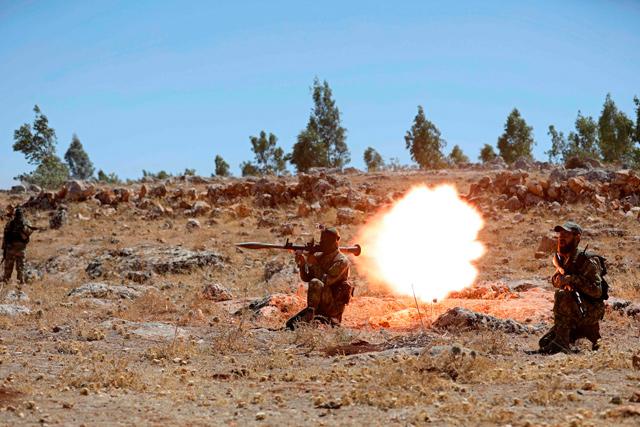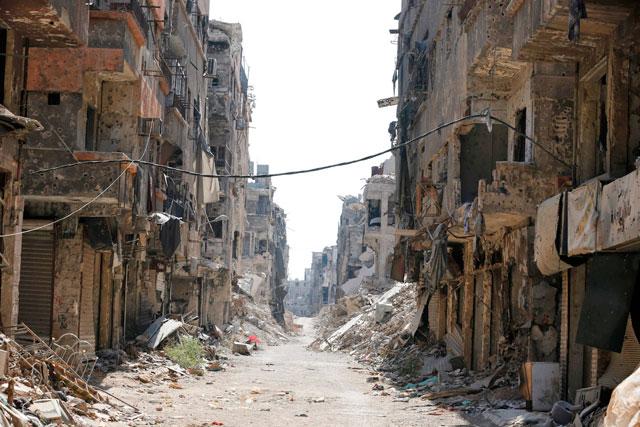You are here
Idlib region: Syria’s last major rebel stronghold
By AFP - Jan 10,2019 - Last updated at Jan 10,2019

This Syrian fighter fires a rocket-propelled grenade as he attends a mock battle in anticipation of an attack by the regime on Idlib province and the surrounding countryside, during a graduation of new Hayat Tahrir Al Sham members at a camp in the countryside of the northern Idlib province on August 14, 2018 (AFP photo)
BEIRUT — Syria’s terrorist-held Idlib region is the last major area still outside regime control, after a string of ferocious assaults last year put most of the country back in government hands.
A Russian-Turkish deal has since September prevented a major regime offensive on the rebel stronghold, made up of much of Idlib province as well as adjacent parts of Hama, Aleppo and Latakia provinces.
On Thursday, an alliance led by Syria’s former Al Qaeda affiliate took administrative control of the whole of the opposition bastion under a deal with rival rebels.
Terrorists seize key areas
The Idlib region shares a border with rebel backer Turkey and is also adjacent to Latakia, a regime stronghold on the Mediterranean coast and the heartland of President Bashar Assad’s clan.
Before Syria’s uprising broke out in 2011, most of Idlib’s inhabitants worked in agriculture, mainly growing cotton and cereals, or commuted to neighbouring Aleppo province.
In March 2015, a coalition of Islamist fighters including some linked to Al Qaeda seized the provincial capital, other key towns and government military installations.
Extremists dominate
Hardcore terrorist factions have since overpowered more moderate rebels.
When regime ally Russia and rebel backer Turkey agreed to a buffer zone around Idlib in September, the extremist-led Hayat Tahrir Al Sham (HTS) controlled more than half of that region.
But fighting and deals since the start of January have seen HTS, an alliance led by Syria’s former Al Qaeda affiliate, extend its administrative control to the whole of the region.
Rebels formerly united under the banner of the Turkey-backed National Liberation Front (NLF) have either withdrawn or are to remain, but dismantle their checkpoints in areas they once controlled.
Other hardliners are also present in the stronghold, but are allied to HTS.
Displaced residents
The Idlib region is said to be home to around three million people, around half of them displaced from other parts of the country which have been recaptured by Russian-backed Syrian regime forces.
The area’s residents include tens of thousands of rebels and civilians transferred since 2014 from areas recaptured by the regime in its notorious ‘‘reconciliation’’ deals.
The United Nations warned last year of a ‘‘civilian bloodbath’’ were the regime to attack the province and said there was ‘‘no other Idlib’’ to which residents could flee.
Chemical attacks
Government forces have been accused of staging several chemical attacks in Idlib.
A UN commission found that helicopters from a pair of regime-controlled air bases dropped chlorine-filled barrel bombs on two Idlib villages in 2014 and 2015.
The commission later concluded that the army also carried out a chemical attack, probably with chlorine, on a third village in 2015.
A sarin gas attack in April 2017 hit the town of Khan Sheikhun, killing 83 people, according to the United Nations.
The Britain-based Syrian Observatory for Human Rights said 87 died, including more than 30 children.
The United Nations blamed the government, which has consistently denied responsibility.
Idlib ‘is our goal’
In 2017, Idlib was declared one of four ‘‘de-escalation’’ zones established by the three main powerbrokers in Syria’s conflict — Turkey, Russia, and fellow regime ally Iran — in a bid to reduce violence.
While there was an initial drop in fighting, the de-escalation zones did not hold.
In late 2017, government forces backed by Russian air power launched an offensive on southeastern Idlib, which ended weeks later with their recapture of dozens of villages and towns there, as well as the military airport of Abu Duhur.
The government then retook the other three de-escalation areas — Eastern Ghouta near Damascus, towns in Homs province, and Syria’s south — in military assaults culminating in surrender deals.
‘‘Now Idlib is our goal,’’ Assad said on July 26.
Buffer zone agreed
In late summer, troops began amassing around the province.
But in an apparent breakthrough after a flurry of meetings between key players in the conflict, Russia and Turkey announced a deal on September 17 to create a buffer zone ringing the Idlib region.
It would separate rebel and regime fighters, averting a massive assault by Assad’s forces.
Radical groups — interpreted as meaning HTS and other jihadists — were supposed to withdraw from the planned buffer by October 15, but they did not.
Related Articles
BEIRUT — A planned buffer zone in northwest Syria has been cleared of heavy armaments, Turkey said Wednesday, as a new deadline loomed for t
BEIRUT, Lebanon — The fate of Syria's Idlib will depend on Turkey's ability to keep a lid on the extremist-dominated tinderbox and prevent a
BEIRUT — Rebel groups in Syria’s Idlib province on Wednesday announced the formation of a new coalition, as President Bashar Assad looks to

















